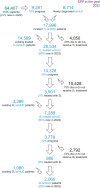Oncology Simulation Model: A Comprehensive and Innovative Approach to Estimate and Project Prevalence and Survival in Oncology
- PMID: 36404878
- PMCID: PMC9673939
- DOI: 10.2147/CLEP.S377093
Oncology Simulation Model: A Comprehensive and Innovative Approach to Estimate and Project Prevalence and Survival in Oncology
Abstract
Objective: We demonstrate a new model framework as an innovative approach to more accurately estimate and project prevalence and survival outcomes in oncology.
Methods: We developed an oncology simulation model (OSM) framework that offers a customizable, dynamic simulation model to generate population-level, country-specific estimates of prevalence, incidence of patients progressing from earlier stages (progression-based incidence), and survival in oncology. The framework, a continuous dynamic Markov cohort model, was implemented in Microsoft Excel. The simulation runs continuously through a prespecified calendar time range. Time-varying incidence, treatment patterns, treatment rates, and treatment pathways are specified by year to account for guideline-directed changes in standard of care and real-world trends, as well as newly approved clinical treatments. Patient cohorts transition between defined health states, with transitions informed by progression-free survival and overall survival as reported in published literature.
Results: Model outputs include point prevalence and period prevalence, with options for highly granular prevalence predictions by disease stage, treatment pathway, or time of diagnosis. As a use case, we leveraged the OSM framework to estimate the prevalence of bladder cancer in the United States.
Conclusion: The OSM is a robust model that builds upon existing modeling practices to offer an innovative, transparent approach in estimating prevalence, progression-based incidence, and survival for oncologic conditions. The OSM combines and extends the capabilities of other common health-economic modeling approaches to provide a detailed and comprehensive modeling framework to estimate prevalence in oncology using simulation modeling and to assess the impacts of new treatments on prevalence over time.
Keywords: Markov; OSM; epidemiology; modeling; oncology; prevalence.
© 2022 Bloudek et al.
Conflict of interest statement
BB, JT, and LB are employees of Curta Inc., paid consultants to Seagen Inc. in connection with this study. HSW and ZH are employees and stockholders of Seagen Inc. HSW is also stockholder of Amgen Inc. and Teva Pharmaceuticals. CM is an employee and stockholder of Astellas, Inc. and also a stockholder of Merck and J&J. MDG has served as an advisory board member and consultant for Aileron Therapeutics, Astellas, AstraZeneca, Basiliea, BioMotiv, BMS, Dendreon, Dracen, Dragonfly, EMD Serono, Genentech, GSK, Incyte, Inovio Pharmaceuticals, Janssen, Lilly, Merck, Novartis, Numab, Pfizer, Seagen Inc., and Urogen; has equity ownership in Rappta Therapeutics; holds patents/royalties for “Methods and compositions for treating cancer and related methods (20120322792)”; and has received research funding from AstraZeneca, BMS, Dendreon, Genentech, Janssen, Merck, and Novartis.
Figures





Similar articles
-
Cohort versus patient level simulation for the economic evaluation of single versus combination immuno-oncology therapies in metastatic melanoma.J Med Econ. 2019 Jun;22(6):531-544. doi: 10.1080/13696998.2019.1569446. Epub 2019 Jan 30. J Med Econ. 2019. PMID: 30638416 Clinical Trial.
-
Italian cancer figures--Report 2015: The burden of rare cancers in Italy.Epidemiol Prev. 2016 Jan-Feb;40(1 Suppl 2):1-120. doi: 10.19191/EP16.1S2.P001.035. Epidemiol Prev. 2016. PMID: 26951748
-
Integrated, cross-sectoral psycho-oncology (isPO): a new form of care for newly diagnosed cancer patients in Germany.BMC Health Serv Res. 2022 Apr 22;22(1):543. doi: 10.1186/s12913-022-07782-0. BMC Health Serv Res. 2022. PMID: 35459202 Free PMC article.
-
Modelling approaches for histology-independent cancer drugs to inform NICE appraisals: a systematic review and decision-framework.Health Technol Assess. 2021 Dec;25(76):1-228. doi: 10.3310/hta25760. Health Technol Assess. 2021. PMID: 34990339
-
20-Year Comparative Survival and Mortality of Cancer of the Stomach by Age, Sex, Race, Stage, Grade, Cohort Entry Time-Period, Disease Duration & Selected ICD-O-3 Oncologic Phenotypes: A Systematic Review of 157,258 Cases for Diagnosis Years 1973-2014: (SEER*Stat 8.3.4).J Insur Med. 2019;48(1):5-23. doi: 10.17849/insm-48-1-1-19.1. Epub 2019 Oct 14. J Insur Med. 2019. PMID: 31609640
Cited by
-
Benchmarking Maintenance Therapy Survival in First-Line Platinum-Based Chemotherapy-Treated Patients with Advanced Urothelial Carcinoma Using Simulated Disease Modeling.Clin Epidemiol. 2023 Jun 21;15:765-773. doi: 10.2147/CLEP.S409791. eCollection 2023. Clin Epidemiol. 2023. PMID: 37366420 Free PMC article.
-
Estimating long-term progression-free and overall survival in patients with peripheral T-cell lymphoma: A US population-based oncology simulation model based on 5-year results from the ECHELON-2 trial.J Manag Care Spec Pharm. 2023 Mar;29(3):314-323. doi: 10.18553/jmcp.2023.29.3.314. J Manag Care Spec Pharm. 2023. PMID: 36840956 Free PMC article.
-
Estimated impact of ECHELON-1 overall survival on productivity costs in stage III/IV classical Hodgkin lymphoma in the United States.J Manag Care Spec Pharm. 2023 Dec;29(12):1312-1320. doi: 10.18553/jmcp.2023.23101. Epub 2023 Nov 3. J Manag Care Spec Pharm. 2023. PMID: 37921077 Free PMC article.
References
-
- National Cancer Institute DoCCPS. Cancer prevalence statistics: approaches to estimation using cancer registry data. National Cancer Institute, Division of Cancer Control & Population Sciences. Available from: https://surveillance.cancer.gov/prevalence/approaches.html. Accessed September 18, 2021.
LinkOut - more resources
Full Text Sources
Research Materials

